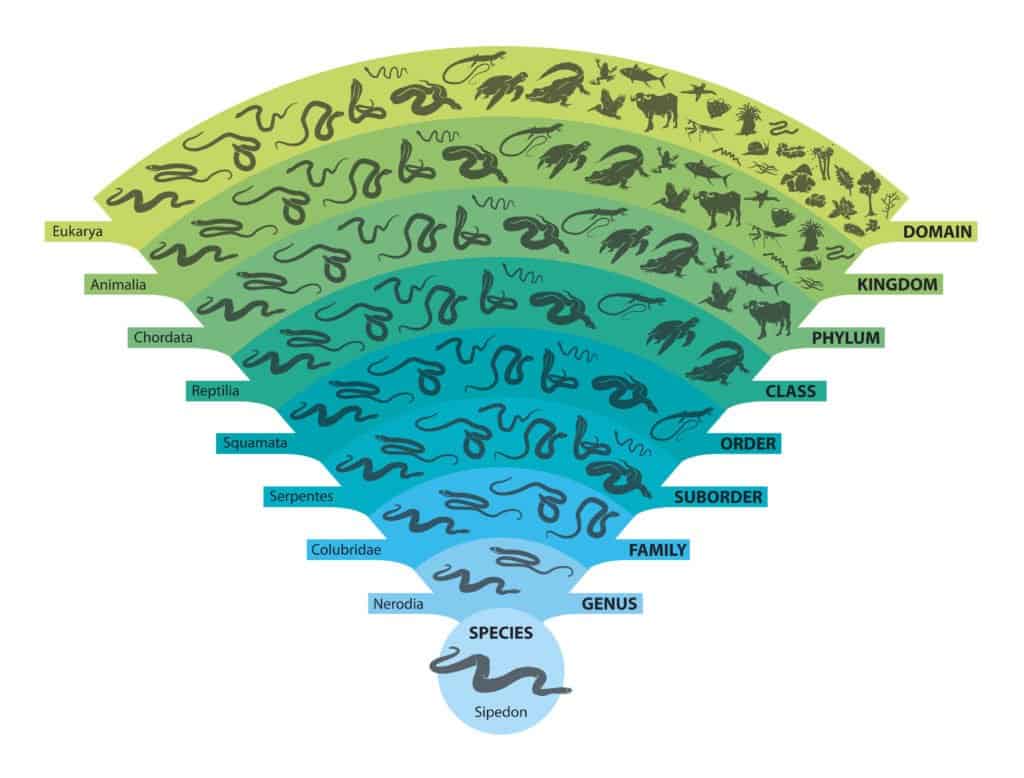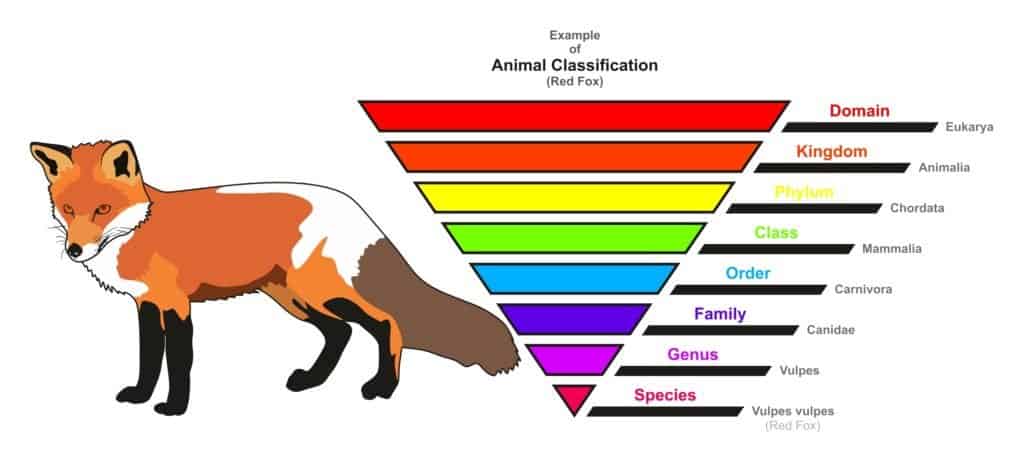What is Animal Classification?
Animal kingdom classification is an important system for understanding how all living organisms are related. Based on the Linnaeus method, species are arranged and grouped based on shared characteristics.
This system of animal kingdom classification was developed by Swedish botanist Carolus (Carl) Linnaeus in the 1700s. The Linnaeus Method, also known as Linnaean Taxonomy, creates a hierarchy of groupings called taxa, as well as binomial nomenclature that gives each animal species a two-word scientific name.
This method of giving scientific names to animals is typically rooted in Latin by combining the genus and species. For example, humans are classified as homo sapiens while wolves are canis lupus.
The more features that a group of animals shares, the more specific that animal classification group is. Every species is defined based on nine branching categories. The primary method of animal classification is:
- Domain
- Kingdom
- Phylum
- Class
- Order
- Suborder
- Animal Families
- Genus
- Species

Animal Classification Chart for Water snake (Nerodia Sipedon)
©EreborMountain/Shutterstock.com
Animal Classification: The Six Different Animal Kingdoms
All living organisms can be placed in one of six different animal kingdom classifications. The characteristics of each animal kingdom are:
- Animal – A kingdom of complex multi-celled organisms that do not produce their own food. This kingdom contains all living and extinct animals. Examples include elephants, whales, and humans.
- Plants – Complex and multi-cellular autotrophic organisms, meaning they produce their own food through photosynthesis. Examples include trees, flowers, and grass.
- Fungi – Multi-celled organisms that do not produce their own food, unlike plants. Examples include molds, mushrooms, and yeast.
- Protista – Single-celled organisms with more complexity than either eubacteria or archaebacteria. Examples include algae and amoebas
- Eubacteria – Single-celled organisms found in everything from yogurt to your intestines. This kingdom contains all bacteria in the world not considered archaebacteria.
- Archaebacteria – The oldest known living organisms. Single-celled and found in hostile and extremely hot areas like thermal vents or hot springs
Animal Phylums Explained
After animal kingdom, animal species usually fall into one of seven different phylum or phyla:
- Porifera – Marine animals more commonly known as sponges and found in every ocean on earth.
- Cnidaria – Mostly marine animals that include over 11,000 species. Examples include coral, jellyfish, and anemones
- Platyhelminthes – Typically parasitic flatworms. Lacking in any respiratory or circulatory system, oxygen passes through their bodies instead in a process known as diffusion. Examples include tapeworms and flukes.
- Annelida – More complex than Platyhelminthes, these are segmented and symmetrical worms containing a nervous system, respiratory system, and sense organs. Examples include the common earthworm and leeches.
- Mollusca – The second largest phylum by species count, and the largest marine phylum. Invertebrates with soft unsegmented bodies. It is estimated almost a quarter of marine life falls in this category. Examples include clams, mussels, and snails
- Arthropoda – Invertebrate animals with an exoskeleton and segmented bodies. Contains insects, crustaceans, and arachnids. This is the largest phylum by species count. Examples include scorpions, butterflies, and shrimp
- Chordata – Vertebrates. Animals that develop a notochord, a cartilaginous skeletal rod that supports the body in the embryo and can often become a spine. Most animals we are familiar with, including dogs, horses, birds, and humans fall into this category.
Animal Classes
The phylum group is then divided into even smaller groups, known as animal classes. The Chordata phylum splits into these seven animal classes:
- Agnatha (jaw-less fish) – Primitive jawless fish including lampreys, hagfishes, and extinct groups.
- Chrondrichtyes (cartilaginous fish) – Composed of fish with skeletons composed of cartilage. Includes two subclasses: Elasmobranchii (rays, skates, sawfish, and sharks); Holocephali (chimaeras–ghost sharks).
- Osteichthyes (bony fish) – Includes saltwater and freshwater fish with bony skeletons like eels, anglerfish, clown fish, swordfish, and catfish, carp, trout, and salmonids.
- Amphibia (amphibians) – Four-limbed, ectothermic vertebrates, including frogs, toads, salamanders, and newts.
- Reptilia (reptiles) – Vertebrates with dry skin and scales such as snakes, turtles, lizards, and crocodilians.
- Aves (birds) – Warm-blooded, egg-laying animals characterized by two wings, two legs, and feathers.
- Mammalia (mammals) – Warm-blooded four-legged (or two-armed, two-legged) animals that breathe with lungs and birth live young.
Different Animal Orders
Each class is divided into small groups again, known as orders. There is no universally accepted breakdown for the class Mammalia. Some outline as many as 26 different orders for the class Mammalia. Some of the most popular examples include:
- Artiodactyla (even-toed hoofed animals) – Examples include moose, camels, and giraffes
- Carnivora – Animals that specialize in mostly eating meat, but also contain some omnivores and herbivores. Characterized as having nonretractable claws and long snouts. Examples include bears.
- Rodentia (gnawing mammals) – Examples include beavers, mice, and squirrels
- Chiropptera (bats) – The only mammals that can fly. Examples include free-tailed and vampire bats
- Cetacea (porpoises and whales) – Examples include killer whales, dolphins, and hump-backed whales
- Primates – Includes prehensile hands and feet, commonly with opposable thumbs. Examples include gorillas, chimpanzees, and humans.
Animal Families
In every order, there are different animal families which are defined by groups that have very similar features. Animal families are basically sub-divided into two main groups–vertebrates and invertebrates.
One example of animal families would be the 12 families that fall under the Carnivora order (Carnivores). The twelve families include:
- Felidae (Cats)
- Canidae (Dogs, Wolves, Coyotes, African Wild Dogs, etc.)
- Ursidae (Bears)
- Mustelidae (Weasels, Badgers, Otters, etc.)
- Procyonidae (Raccoons, Coatis, Olingos, etc.)
- Mephitidae (Skunks, Stink Badgers)
- Herpestidae (Mongooses)
- Hyaenidae (Hyenas)
- Viverridae (Civets, Genets, and Linsangs)
- Otariidae (Sea Lions, Fur Seals)
- Phocidae (True Seals)
- Odobenidae (Walrus)
An additional example would be Lagomorphs, falling under the order Lagomorpha and containing two families:
- Leporidae (Rabbits and Hares)
- Ochotonidae (Pikas)
Animal Genus Types
Every animal family is further divided into smaller groups known as genera, or genuses. Each genus contains animals that have very similar features and are closely related.
For example, the Felidae (Cat) family contains genuses including:
- Felis (small Cats and domestic Cats)
- Panthera (Tigers, Leopards, Jaguars and Lions)
- Pumas (Panthers and Cougars)
- Leopardus (American Spotted Cats)
- Lynxes
- Neofelis (Clouded Leopard, Suna Clouded Leopard)
- Prionailurus (Asian Spotted Wildcats)
- Acinonyx (Cheetah)
- Catopuma (Asian Golden Cat and Baby Cat)
- Saber-toothed Cats (Extinct)
- Proailurus (Extinct)
- Pardofelis (Marbled Cat)
- Pseudaelurus (Extinct)
- Homotherium (Scimitar-toothed cat, Extinct)
- Caracal (Serval and African Golden Cats)
- Asiatic Linsangs (Banded and Spotted Linsangs)
- Sivaelurus (Extinct)
- Miopanthera (Extinct)
- Machairodus (Extinct)
- Paramachairodus (Extinct)
- Megantereon (Extinct)
- Styriofelis (Extinct)
- Metailurus (Extinct)
- Machairodus (Extinct)
- Dinofelis (Extinct)
- Leptailurus
- American Cheetah (Extinct)
- Sivapanthera (Extinct)
- Leptofelis
- Namafelis
- Asilifelis
- Diamantofelis
- Yoshi
- Mellivorodon
- Uncia
- Nimravides
- Xenosmilus
- Adelphailurus
- Nimravus
- Lokotunjailurus
- Rhizosmilodon
- Amphimachairodus
- Bassariscus
- Nasua
- Cryptoprocta (Fossa)
- Viverra
- Genet
Animal Species Names
Each species within the genus is named after its features and characteristics. The names of animals are based in Latin and consist of two words. The first word in the name of an animal will be the genus, and the second name indicates the specific species. This method of organizing scientific names of animal species was developed by Carl Linnaeus in the 1700’s. As an example, a dolphin species name is Delphinus Delphis. A red fox is Vulpes vulpes. This animal classification chart of a red fox is an example of Linnaean Taxonomy:

An animal classification for
red fox
, based on the Linnaeus Method
©udaix/Shutterstock.com
Animal Classification Example 1 – Red Fox
- (Vertebrate)
- Class: Mammalia (Mammal)
- Order: Carnivora (Carnivore)
- Family: Canidae (Dog)
- Genus: Vulpes
- Species: Vulpes vulpes (red fox)
Animal Classification Example 2 – Orang-utan
- Kingdom: Animalia (Animal)
- Phylum: Chordata (Vertebrate)
- Class: Mammalia (Mammal)
- Order: Primates
- Family: Hominidae (Great Apes)
- Genus: Pongo
- Species: Pongo pygmaeus (Orang-Utan)












